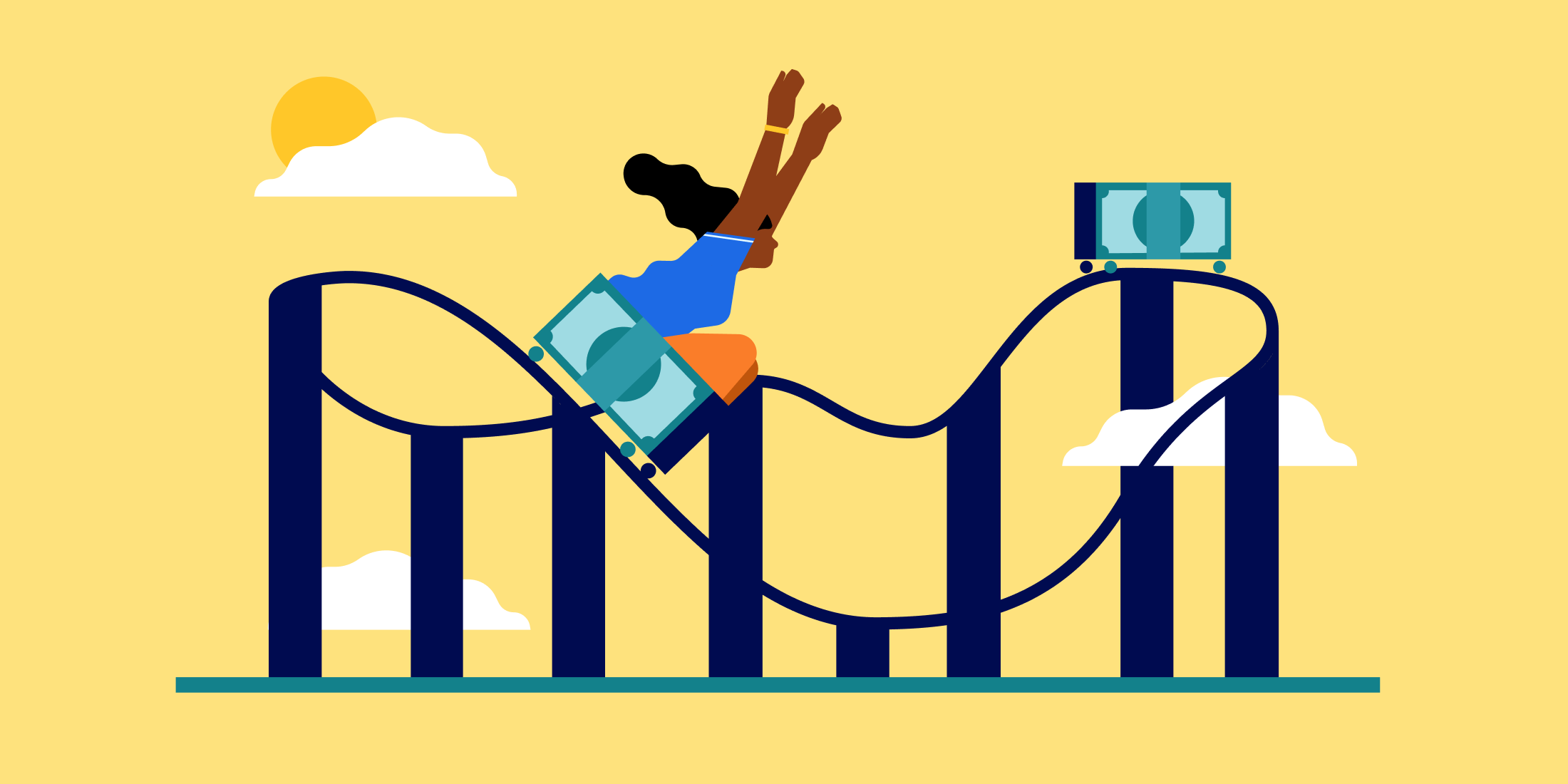Markets

Featured articles
-
![]()
Four keys to riding the market's ups and downs
Let time work in your favor. Let the market worry about itself.
Four keys to riding the market's ups and downs Let time work in your favor. Let the market worry about itself. Financial markets are unpredictable. No matter how much research you do and how closely you follow the news, trying to “time the market” usually means withdrawing too early and investing too late. In this guide, we’ll explain: Why a long-term strategy is often the best approach The problems with trying to time the market How to accurately evaluate portfolio performance How to make adjustments when you need to Why a long-term strategy is often the best approach Watch the market closely, and you’ll see it constantly fluctuate. The markets can be sky high one day, then come crashing down the next. Zoom in close enough on any ten-year period, and you’ll see countless short-term gains and losses that can be large in magnitude. Zoom out far enough, and you’ll see a gradual upward trend. It’s easy to get sucked into market speculation. Those short-term wins feel good, and look highly appealing. But you’re not trying to win the lottery here—you’re investing. You’re trying to reach financial goals. At Betterment, we believe the smartest way to do that is by diversifying your portfolio, making regular deposits, and holding your assets for longer. Accurately predicting where the market is going in the short-term is extremely difficult, but investing regularly over the long-term is an activity you can control that can lead to far more reliable performance over time. The power of compounding is real. By regularly investing in a well-diversified portfolio, you’re probably not going to suddenly win big. But you’re unlikely to lose it all, either. And by the time you’re ready to start withdrawing funds, you’ll have a lot more to work with. The basics of diversification Diversification is all about reducing risk. Every financial asset, industry, and market is influenced by different factors that change its performance. Invest too heavily in one area, and your portfolio becomes more vulnerable to its specific risks. Put all your money in an oil company, and a single oil spill, regulation, lawsuit, or change in demand could devastate your portfolio. There’s no failsafe. The less you lean on any one asset, economic sector, or geographical region, the more stable your portfolio will likely be. Diversification sets your portfolio up for long-term success with steadier, more stable performance. The problems with trying to time the market There are two big reasons not to try and time the market: It’s difficult to consistently beat a well-diversified portfolio Taxes Many investors miss more in gains than they avoid in losses by trying to time a dip. Even the best active investors frequently make “the wrong call.” They withdraw too early or go all-in too late. There are too many factors outside of your control. Too much information you don’t have. To beat a well-diversified portfolio, you have to buy and sell at the perfect time. Again. And again. And again. No matter how much market research you do, you’re simply unlikely to win that battle in the long run. Especially when you consider short-term capital gains taxes. Any time you sell an asset you’ve held for less than a year and make a profit, you have to pay short-term capital gains taxes. Just like that, you might have to shave up to 37% off of your profits. With a passive approach that focuses on the long game, you hold onto assets for much longer, so you’re far less likely to have short-term capital gains (and the taxes that come with them). Considering the short-term tax implications, you don’t just have to consistently beat a well-diversified, buy-and-hold portfolio. In order to outperform it by timing the market, you have to blow it out of the water. And that’s why you may want to rethink the way you evaluate portfolio performance. How to evaluate portfolio performance Want to know how well your portfolio is doing? You need to use the right benchmarks and consider after-tax adjustments. US investors often compare their portfolio performance to the S&P 500 or the Dow Jones Industrial Average. But that’s helpful if you’re only invested in the US stock market. If you’re holding a well-diversified portfolio holding stocks and bonds across geographical regions, the Vanguard LifeStrategy Funds or iShares Core Allocation ETFs may be a better comparison. Just make sure you compare apples to apples. If you have a portfolio that’s 80% stocks, don’t compare it to a portfolio with 100% stocks. The other key to evaluating your performance is tax adjustments. How much actually goes in your pocket? If you’re going to lose 30% or more of your profits to short-term capital gains taxes, that’s a large drain on your overall return that may impact how soon you can achieve your financial goals. How to adjust your investments during highs and lows At Betterment, we believe investors get better results when they don’t react to market changes. On a long enough timeline, market highs and lows won’t matter as much. But sometimes, you really do need to make adjustments. The best way to change your portfolio? Start small. Huge, sweeping changes are much more likely to hurt your performance. If stock investments feel too risky, you can even start putting your deposits into US Short-Term Treasuries instead, which are extremely low risk, highly liquid, and mature in about six months. This is called a “dry powder” fund. Make sure your adjustments fit your goal. If your goal is still years or decades away, your investments should probably be weighted more heavily toward diversified stocks. As you get closer to the end date, you can shift to bonds and other low-risk assets. Since it’s extremely hard to time the market, we believe it’s best to ride out the market highs and lows. We also make it easy to adjust your portfolio to fit your level of risk tolerance. It’s like turning a dial up or down, shifting your investments more toward stocks or bonds. You’re in control. And if “don’t worry” doesn’t put you at ease, you can make sure your risk reflects your comfort level. -
![]()
Why it’s not your time to time the market
History shows that timing the market is a fool's errand. Instead, here are two investing ...
Why it’s not your time to time the market History shows that timing the market is a fool's errand. Instead, here are two investing approaches to help build wealth over time. The main idea: Timing the market can be risky and takes a lot of effort and skill (or luck!) to be successful. History is not on the side of timing the market. Study after study after study after study—you get the point—has shown the risks of timing the market and how a more general buy-and-hold strategy can help investors increase their portfolio performance. The risks of timing the market include: Poor timing and investing when asset prices are at a higher point. Missing high-performing periods, even single days or months, when the market increases. Timing the market also takes a lot of work: Successful market timing usually requires analysis and forecasting techniques that can be quite advanced. Market timing also requires a dedication of time as you need to be constantly tracking and analyzing the market. Instead, consider these two approaches. Both can work well if you have long-term investing goals. Lump-sum investing is depositing the entire balance of cash at once. This method works well if you have extra cash and are looking to maximize the time your funds are invested. It lowers the likelihood that you miss out on any high-performing periods. Keep in mind that your entire lump sum is at risk if the market decreases. Dollar-cost averaging is depositing the same amount of money at fixed intervals (weekly, monthly, etc) over a period of time. This approach works well if you want to take less risk with a lump sum of cash and protect against short-term market declines, or if you only have money to save after each paycheck. Either way, both options are less risky than timing the market and less work for you to manage. -
![]()
When will interest rates finally start to fall?
We look back at the last 40 years of interest rate peaks and plateaus for a guide.
When will interest rates finally start to fall? We look back at the last 40 years of interest rate peaks and plateaus for a guide. This decade of investing has come to be defined by one thing: interest rates. The federal funds rate has sat north of 5% for more than a year now, a level neither seen nor sustained since the runup to the Great Recession. Which has everyone from bond traders to homebuyers asking the same question: When will rates finally start to fall? Optimism that the Federal Reserve would cut rates throughout 2024 was widespread to begin the year, but inflation’s small uptick to start the year has thrown cold water on those expectations. So how far in the future could the first cut be? No one knows the exact answer, but history offers several reference points. Rate peaks are common, plateaus less so When you take a look at the past 40 years, the cyclical nature of short-term rates stands out: The economy heats up, the Fed raises rates. The economy cools down, the Fed lowers rates. Rinse and repeat. Historically-speaking, however, it’s usually only a matter of months until rates drop after peaking, which means our current cycle is starting to look more like a plateau by comparison. It’s already lasted longer than all but one other cycle since the 1980s. Rate peaks have lasted 8 months on average since the late 80s This holding pattern isn’t without reason, of course. Inflation has slowed considerably since 2022, but it’s been stuck in its own holding pattern as of late, hovering more than a full percentage point over the Fed’s stated target of 2%. On the flip side, supply and demand appear better balanced, so if inflation resumes its slowdown in the coming months, then signs point to possible rate cuts late in the year. So what’s a saver to do? Consider deploying excess dollars Whenever the federal funds rate falls, other interest rates follow, including variable interest rates on high-yield cash accounts. Stocks and bonds, on the other hand, tend to benefit from rate cuts. Because of this, we suggest taking another look at your cash situation. If you’ve been stockpiling cash above and beyond an emergency fund and other major purchases, it may be the time to start investing some of that excess in the coming months. Feeling anxious about diving into the market right now? Our all-bonds BlackRock Target Income portfolio offers the potential for higher yields than cash in exchange for taking on some risk. If or when a long-term goal comes to mind for those funds, consider switching to a diversified portfolio of stocks and bonds. And keep in mind you don’t have to move all your money at once. With a few clicks, you can set up a recurring internal transfer to slowly but steadily dollar-cost average your way from cash to investing.
Considering a major transfer? Get one-on-one help with one of our experts. Explore our licensed concierge
Looking for a specific topic?
- App
- Behavioral finance
- Buying Real Estate
- Career Planning
- Cash Reserve
- Charitable Giving
- Crypto investing
- DIY Investing
- Debt
- Diversification
- ESG Investing
- Education Savings
- Estate Planning
- Fiduciary Advice
- Filing Taxes
- Financial Advisors
- Financial Goals
- Health Savings
- Inheritances
- Insurance
- Investing
- Investing Philosophy
- Investing Risk
- Investing with Betterment
- Investment Accounts
- Investment Portfolios
- Market volatility
- Markets
- Performance
- Public statements
- Retirement Income
- Retirement Planning
- Robo-Advisors
- Rollovers
- Salaries and Benefits
- Saving Money
- Savings Accounts
- Security
- Shared Finances
- Tax Coordination
- Taxes
- Transfers
- Using IRAs
- bond investing
No results found



